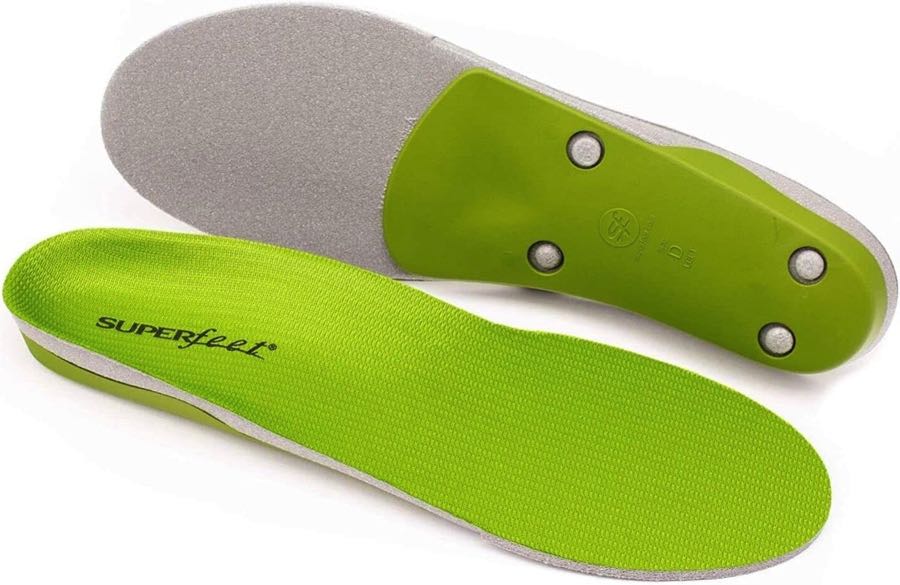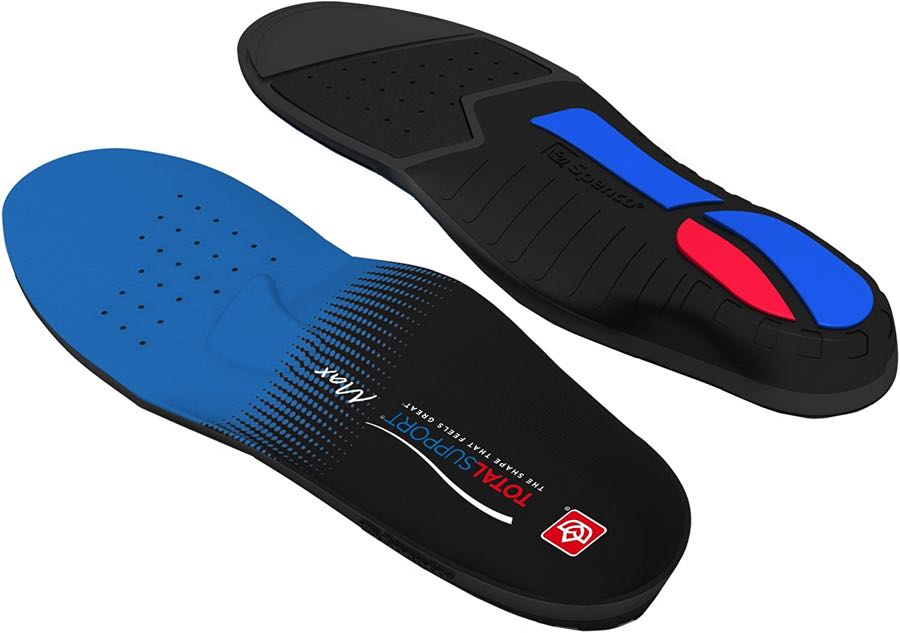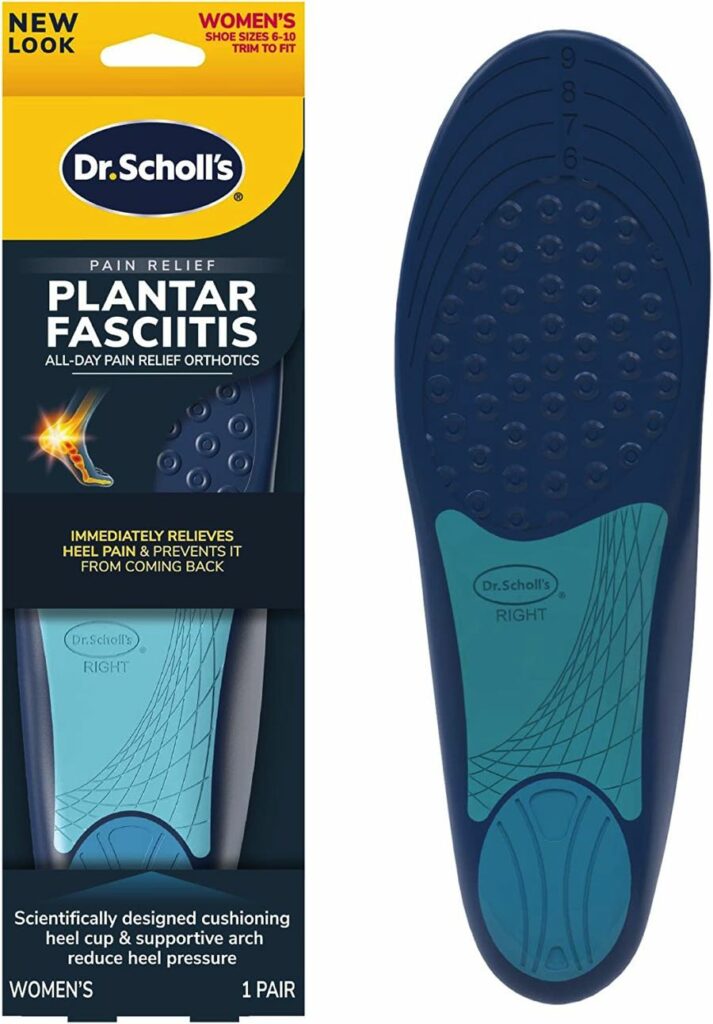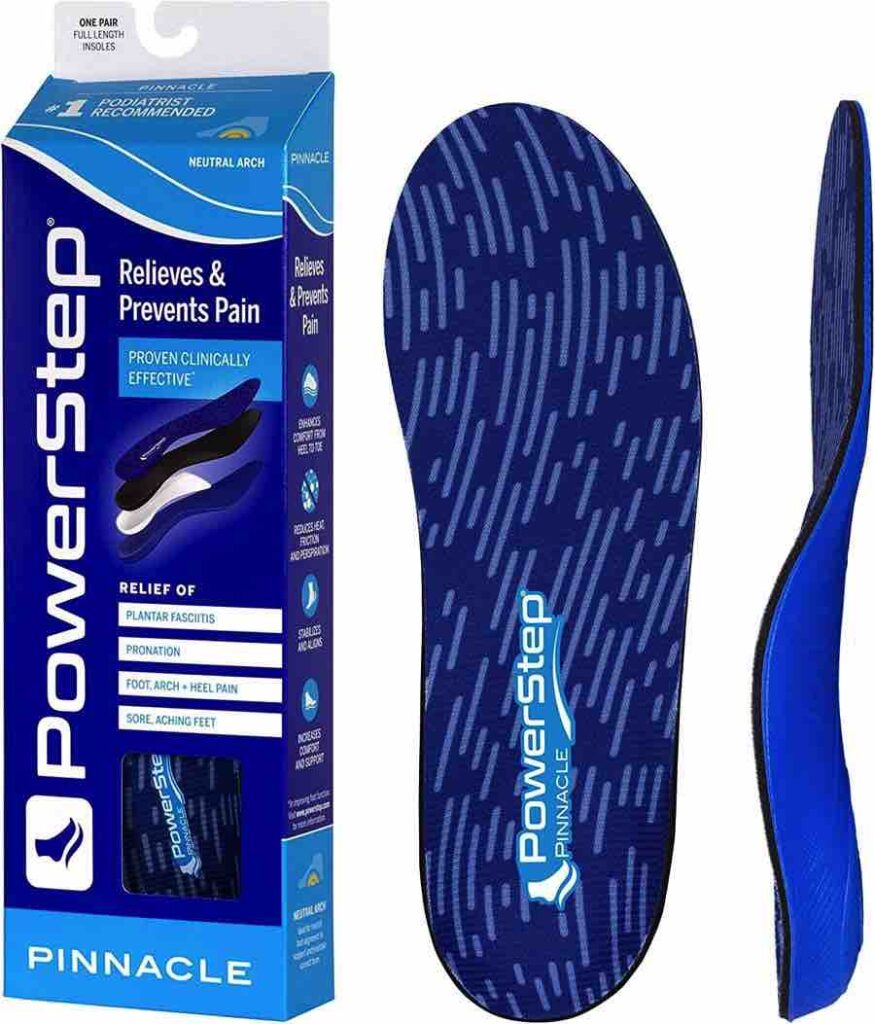As someone who has suffered from plantar fasciitis, I know the pain and discomfort it can cause. Every step feels like a sharp knife stabbing into the heel, making even the simplest tasks unbearable. However, there is hope. Insoles specifically designed for plantar fasciitis can provide much-needed relief and make walking and standing more manageable.
With so many insoles on the market, it can be overwhelming to choose the right one. That’s why we’ve compiled a list of the top 5 best insoles for plantar fasciitis. Whether you’re an athlete or someone who spends long hours on their feet, we’ve got you covered.
In this article, we’ll dive into what plantar fasciitis is, how insoles can help, and what factors to consider when choosing the right insole for you. So, let’s get started and say goodbye to plantar fasciitis pain once and for all.

Key Takeaways
- Plantar fasciitis is a common condition that causes pain in the heel and bottom of the foot, and insoles with arch support can help reduce the pressure on the plantar fascia ligament.
- The best insoles for plantar fasciitis often come with extra cushioning to absorb shock and reduce impact while walking or standing, and are often made with materials that provide added stability to the foot.
- Insoles purchased over-the-counter may not fit your feet perfectly, so it’s recommended to visit a podiatrist for a customized fit that will provide the maximum amount of support and comfort.
- When buying insoles for plantar fasciitis, important factors to consider include arch support, cushioning, heel cup depth, firmness, shape, material, size, and fit, and it’s crucial to break in the new insoles gradually for optimal comfort and support.
What is Plantar Fasciitis and How Can Insoles Help?
Let’s talk about Plantar Fasciitis and how insoles can help alleviate the pain.
Plantar Fasciitis is a common condition that causes pain in the heel and bottom of the foot. Insoles can provide extra cushioning and arch support to reduce the pressure on the Plantar Fascia.
Before purchasing insoles, it’s important to understand what to look for and whether it’s necessary to visit a podiatrist for a custom fit.
Understanding Plantar Fasciitis and its Causes
Plantar fasciitis is a painful condition that occurs when the thick band of tissue running across the bottom of the foot, from the heel to the toes, becomes inflamed and irritated. It is a common foot problem that affects millions of people worldwide, particularly those who engage in physical activities that place a lot of stress on the feet, such as running, jumping, and standing for long periods. The condition is characterized by sharp, stabbing heel pain, especially in the morning or after prolonged periods of inactivity.
There are several factors that can contribute to the development of plantar fasciitis, including obesity, flat feet, high arches, and overuse of the feet. Other risk factors include age, gender, and certain medical conditions such as diabetes and arthritis.
To alleviate the symptoms of plantar fasciitis, various treatments are available, including the use of insoles with arch support. Insoles are designed to provide extra cushioning and support to the feet, reducing the pressure on the plantar fascia and relieving heel pain.
By incorporating insoles with arch support into your daily routine, you can improve your plantar fasciitis symptoms and enjoy a more comfortable and pain-free life. Be sure to consult with a healthcare professional for a proper diagnosis and treatment plan for your specific case.
How Insoles Address Plantar Fasciitis Pain?
Wearing arch support insoles can significantly alleviate the sharp, stabbing heel pain associated with plantar fasciitis. Here’s how:
- Arch support: Insoles designed for plantar fasciitis have added arch support to help reduce the pressure on the plantar fascia ligament. This added support helps distribute weight evenly throughout the foot, reducing strain on the plantar fascia and alleviating pain.
- Cushioning: The best insoles for plantar fasciitis often come with extra cushioning to absorb shock and reduce impact while walking or standing. This added cushioning can help reduce pain and inflammation in the heel and arch of the foot.
- Stability: Insoles designed for plantar fasciitis are often made with materials that provide added stability to the foot. This prevents the foot from rolling inward (pronation), which can cause further strain on the plantar fascia ligament.
- Customization: Many of the best insoles for plantar fasciitis can be customized to fit your specific foot shape and arch type. This customization ensures the insole provides the right level of support and cushioning where you need it most, helping to relieve plantar fasciitis pain.
Investing in a good quality pair of insoles with arch support, cushioning, stability, and customization can provide significant pain relief and help you get back to your daily activities with less discomfort.
Benefits of Wearing Insoles
Enhance your comfort and alleviate pain with the added support and cushioning of custom-fit insoles, allowing you to confidently tackle your day-to-day activities. Wearing plantar fasciitis insoles can help relieve pain and prevent further damage to your feet. These insoles are designed to provide arch support, which helps to distribute the weight of your body evenly across your feet, reducing pressure on your plantar fascia. They also come equipped with heel cups, which help to absorb shock and provide additional cushioning to protect your feet from further damage.
When it comes to orthotics for plantar fasciitis, the benefits of wearing insoles are numerous. Not only do they help alleviate pain and provide added support, but they also improve your overall foot health. The table below highlights some of the key benefits of wearing plantar fasciitis insoles, including improved posture, reduced fatigue, and increased comfort. With their custom-fit design and specialized features, these insoles are a must-have for anyone suffering from plantar fasciitis.
| Benefit | Description |
|---|---|
| Improved posture | Insoles provide support to your feet, which helps to improve your overall posture. |
| Reduced fatigue | By supporting your feet and providing added cushioning, insoles can help reduce fatigue and prevent foot injuries. |
| Increased comfort | Insoles offer additional cushioning and support, making them comfortable to wear for extended periods of time. |
What to Look for in Plantar Fasciitis Insoles?
When shopping for insoles to relieve plantar fasciitis, it’s crucial to consider the arch support and shock-absorbing capabilities of the product. The arch support helps distribute pressure evenly across your feet and reduces the strain on your plantar fascia. Shock absorption helps to reduce the impact of your feet on hard surfaces, which can be particularly beneficial for individuals who spend long hours standing or walking.
The best insoles for plantar fasciitis don’t necessarily have to be custom-made orthotics. While orthotics for plantar fasciitis can provide excellent support, there are also many over-the-counter insoles that can help alleviate pain and discomfort. Some insoles come with gel heel cups that help cushion your heels and provide extra support.
By considering these factors, you can find the best insoles for plantar fasciitis that suit your needs and lifestyle.
Do I Need to Visit a Podiatrist to Get Insoles?
If you’re experiencing foot pain, it’s important to know that nearly 75% of Americans will experience some type of foot problem in their lifetime, and visiting a podiatrist can help determine if insoles are necessary for your specific condition. While over-the-counter plantar fasciitis insoles can provide some relief, a podiatrist can help provide a more customized solution that targets the specific needs of your feet.
Here are three reasons why visiting a podiatrist for insoles for plantar fasciitis relief is worth considering:
- Proper Diagnosis: A podiatrist can accurately diagnose your condition and determine the underlying cause of your foot pain. This can help ensure that the insoles you receive are tailored to your specific needs and will provide the most effective relief.
- Customized Fit: Insoles for plantar fasciitis shoe inserts that are purchased over-the-counter may not fit your feet perfectly, which can lead to discomfort and even exacerbate the problem. A podiatrist can create a customized fit that will provide the maximum amount of support and comfort.
- Long-term Relief: While over-the-counter plantar fasciitis insoles can provide temporary relief, a podiatrist can help address the underlying problem and provide a long-term solution. This can help prevent reoccurrence of the condition and provide lasting relief for your foot pain.
Choosing the Best Insole: Our Top Picks
As we continue our discussion on the best insoles for plantar fasciitis, let’s talk about our top picks.
Firstly, the Superfeet Green Insoles take the crown as the best overall due to their excellent support and durability.
Secondly, the Spenco Total Support Max Shoe Insoles are the perfect choice for those needing arch and heel support.
For those looking for extra cushioning, the Gel Insoles are our top pick.
Additionally, Dr. Scholl’s Plantar Fasciitis Pain Relief Orthotics are the best option for work shoes, while the Powerstep Pinnacle Insoles are perfect for those with flat feet.
Superfeet Green Insoles: Best Overall
You’ll love the Superfeet Green insoles as they’ve been named the best overall insole for plantar fasciitis in 2023. These plantar fasciitis insoles are designed to provide maximum arch support, which helps to relieve pain associated with this condition. When you slip them into your shoes, you can feel the difference in the level of comfort immediately.
Here are three reasons why the Superfeet Green insoles are the best overall choice for plantar fasciitis:
- They’re made from high-quality materials that are durable and long-lasting.
- They provide excellent arch support, which helps to alleviate pain and discomfort.
- They’re designed to fit most shoe sizes, making them a versatile choice for anyone who suffers from plantar fasciitis.
Overall, if you’re looking for the best insoles for plantar fasciitis, then the Superfeet Green insoles are definitely worth considering. They’re comfortable, supportive, and effective at relieving pain, making them a great investment in your foot health.
Spenco Total Support Max Shoe Insoles: Best for Arch and Heel Support
To properly alleviate the discomfort caused by plantar fasciitis, consider investing in Spenco Total Support Max Shoe Insoles. These insoles are recognized as one of the best insoles for plantar fasciitis, thanks to their unparalleled arch and heel support.
With these insoles, you can walk with ease and comfort, without worrying about the pain caused by the condition. The Spenco Total Support Max Shoe Insoles are designed to provide plantar fasciitis relief by supporting the arch and heel.
They’re made with a 3-pod cushioning system that absorbs shock, reducing the pressure on your feet. Additionally, these orthotics for plantar fasciitis feature deep heel cups and a metatarsal dome that help distribute weight evenly across your feet.
This helps to reduce the stress on your plantar fascia, allowing you to walk without experiencing any discomfort. If you’re looking for the best insoles to alleviate plantar fasciitis, the Spenco Total Support Max Shoe Insoles are an excellent choice.
Dr. Scholl’s Plantar Fasciitis Pain Relief Orthotics: Best for Work Shoes
When you’re on your feet at work all day, finding the right insoles for plantar fasciitis can make all the difference in alleviating discomfort and providing extra support.
That’s where Dr. Scholl’s Plantar Fasciitis Pain Relief Orthotics come in. These insoles are specifically designed to provide targeted support to the arch and heel, two areas that are most affected by plantar fasciitis.
What sets Dr. Scholl’s Plantar Fasciitis Pain Relief Orthotics apart is their ability to absorb shock and reduce impact on the foot. This is especially important for those in professions that require a lot of standing or walking.
The insoles are also made with durable materials that can withstand daily wear and tear. If you suffer from plantar fasciitis at work, consider giving Dr. Scholl’s Plantar Fasciitis Pain Relief Orthotics a try for long-lasting relief.
Powerstep Pinnacle Insoles: Best for Flat Feet
One option for those with flat feet is the Powerstep Pinnacle Insoles, which have been touted for their ability to provide support and comfort. These insoles are designed to relieve pain caused by plantar fasciitis and other foot conditions. They feature a contoured shape that supports the arch of the foot, as well as a deep heel cup that helps to stabilize the foot and prevent overpronation.
The Powerstep Pinnacle Insoles are made from high-quality materials that are both durable and comfortable. They feature a dual-layer cushioning system that provides excellent shock absorption, as well as a antimicrobial top fabric that helps to prevent odor and bacteria buildup. Additionally, these insoles are designed to fit most shoe sizes and can be easily trimmed to fit your specific needs. Overall, the Powerstep Pinnacle Insoles are a great choice for those with flat feet who are looking for the best insoles for plantar fasciitis relief.
| Pros | Cons |
|---|---|
| Provides excellent arch support | May take some time to get used to |
| Dual-layer cushioning system for shock absorption | May not fit all shoe types |
| Antimicrobial top fabric to prevent odor and bacteria buildup | May be more expensive than other insoles |
Factors to Consider While Buying Insoles for Plantar Fasciitis
When it comes to buying insoles for plantar fasciitis, there are several key factors to consider.
Firstly, arch support is crucial as it helps to distribute weight and reduce strain on the plantar fascia.
Secondly, cushioning provides shock absorption and helps to reduce pain and discomfort.
Thirdly, heel cup depth is important as it helps to stabilize the heel and prevent excessive pronation.
Other factors to consider include insole material, size, and fit, as these can affect the overall comfort and effectiveness of the insoles.
Arch Support
You deserve relief from the constant pain caused by plantar fasciitis, and the best way to achieve that is by investing in insoles with proper arch support. Arch support is crucial in reducing the pressure and strain on the plantar fascia, the ligament that connects your heel bone to your toes.
When it comes to choosing the best insoles for plantar fasciitis, high arch support is one of the key factors to consider. Here are three things to look for in insoles with great arch support:
- Firmness: The insoles should be firm enough to provide support to your feet, but not so hard that they cause discomfort.
- Shape: The shape of the insoles should match the curve of your feet. This helps to distribute your body weight evenly and prevent overpronation.
- Material: Look for insoles made from materials that offer both comfort and support. The Spenco Total Support Max insoles, for example, use a combination of foam and gel to provide excellent cushioning and arch support.
Investing in insoles with high arch support is a great step towards plantar fasciitis relief. Not only will they help to reduce pain and discomfort, but they can also prevent further damage to your feet.
With so many options available, make sure to choose insoles that meet your needs and fit well in your shoes.
Cushioning
Feel like you’re walking on clouds with insoles that provide cushioning to your sore feet, helping to absorb shock and reduce pressure on the plantar fascia. Cushioning is an important feature to consider when choosing shoe insoles to treat plantar fasciitis. It helps to provide extra support and comfort to your feet, especially when standing or walking for long periods of time.
To help you choose the best cushioning insoles for plantar fasciitis, we have created a table with five options below. Each of these support insoles has varying levels of cushioning, as well as other features such as arch support and heel cushioning. Take a look at the table to find the insole that best fits your needs and helps to alleviate the pain and discomfort associated with plantar fasciitis.
| Insole | Cushioning Level | Arch Support | Heel Cushioning |
|---|---|---|---|
| Powerstep Pinnacle Plus | High | Yes | Yes |
| Superfeet Green | High | Yes | No |
| Dr. Scholl’s Pain Relief | Medium | Yes | Yes |
| Sof Sole Airr Orthotic | Medium | Yes | Yes |
| Spenco Total Support Max | Low | Yes | Yes |
Remember, cushioning is just one factor to consider when choosing insoles for plantar fasciitis. Be sure to also consider the level of arch support and heel cushioning that you need. With the right combination of these features, you can find the perfect insole to help treat your plantar fasciitis and get back to enjoying your daily activities without pain and discomfort.
Heel Cup Depth
Take a look at the depth of the heel cup in your insoles, as this can greatly affect the stability and support of your feet. Insoles are designed to treat plantar fasciitis by providing extra cushioning and support for the heel bone, arch, and ball of the foot. However, the depth of the heel cup is just as critical, as it helps to stabilize the heel bone and prevent overpronation.
A deep heel cup is especially important for those with plantar fasciitis, as it helps to redistribute pressure away from the heel and towards the arch and ball of the foot. This can help to reduce pain and inflammation in the plantar fascia, while also improving overall foot alignment.
When shopping for insoles, look for options with a deep heel cup that fit snugly against the heel of your foot. This will help to provide the necessary support and stability to prevent further damage to the plantar fascia and promote proper foot alignment.
Insole Material
The material of your shoe insoles is essential to consider when treating plantar fasciitis. It’s a common foot condition that causes discomfort on the heel or arch of the foot. Podiatrists often recommend orthotic insoles or plantar fasciitis orthotics to provide relief. High-quality insoles can offer excellent cushioning, shock absorption, and arch support.
There are different types of insole materials available such as gel, foam, cork, and leather. Gel insoles are popular among people who prefer extra cushioning and shock absorption. Foam insoles are lightweight and comfortable, and they’re recommended for people with mild to moderate plantar fasciitis. Cork insoles provide excellent arch support and are suitable for people with flat feet or high arches. Leather insoles are durable and breathable, making them an ideal choice for people who need to wear their insoles for an extended period.
Ultimately, the best material for your insoles depends on your personal preferences and the severity of your plantar fasciitis.
Size and Fit
Proper sizing and fitting of orthotic insoles are crucial for alleviating discomfort caused by plantar fasciitis. When shopping for shoe insoles to treat plantar fasciitis, it’s important to choose the right size to ensure optimal arch support and shock absorption.
A well-fitted insole will provide the necessary support to the arches of your feet, reducing pressure on the plantar fascia and helping to relieve plantar fasciitis symptoms. When trying on insoles, ensure that they fit snugly inside your shoes without moving around.
Most insoles are designed to be trim-to-fit, allowing you to customize the size to your needs. It’s important to follow the manufacturer’s instructions when trimming the insoles to avoid damaging the material.
Taking the time to properly size and fit your insoles can make all the difference in treating plantar fasciitis and reducing pain and discomfort in your feet.
How to Use Insoles for Plantar Fasciitis?
Now that we’ve chosen the best insoles for plantar fasciitis, let’s discuss how to use them effectively.
First and foremost, it’s crucial to choose the correct size and fit for your insoles. Improper sizing can lead to discomfort and worsen your condition.
Once you have the correct size, it’s important to insert the insoles properly in your shoes to provide optimal support and cushioning.
Lastly, breaking in and adjusting to the new insoles may take some time, but it’s necessary for optimal comfort and relief.
How to Choose the Correct Size and Fit?
First, it’s crucial to find the perfect size and fit for plantar fasciitis insoles to effectively treat the condition. To do so, use a flexible tape or ruler to measure the length and width of your feet. Take note of the larger foot measurement, as this will determine the size of the insole you need.
It’s also important to consider the arch height of your foot, as different insoles offer varying levels of support. When looking for the best insoles for plantar fasciitis, consider the following factors to ensure a proper fit:
- Material: Look for insoles made of breathable materials to prevent moisture buildup and odor.
- Arch support: Choose an insole with adequate arch support to help distribute pressure evenly across your foot.
- Comfort: The insole should feel comfortable and not cause any discomfort or pain.
By taking the time to find the best fitting shoe insoles for your needs, you’ll be able to effectively treat plantar fasciitis and improve your overall foot health.
Inserting the Insoles Properly in Your Shoes
To ensure maximum effectiveness and comfort, it’s important to properly insert your chosen shoe insoles for treating plantar fasciitis.
First, remove the existing insoles from your shoes before inserting the new ones. This ensures that the new insoles fit properly and don’t cause any discomfort or unnecessary pressure points.
Next, position the insoles in the shoe so that they align with the arch of your foot. Make sure that the heel of the insole is positioned snugly against the back of the shoe.
Once you’ve positioned the insoles correctly, simply slip your feet into the shoes and adjust the laces or straps as needed. Properly inserting your insoles can make a big difference in providing relief from foot pain associated with plantar fasciitis.
In addition to ensuring proper alignment, it’s also important to periodically check the insoles for signs of wear and tear. Over time, the insoles may become compressed or lose their shape, which can reduce their effectiveness. If you notice any signs of wear or discomfort, it may be time to replace your insoles.
By taking the time to properly insert and maintain your insoles, you can help alleviate the symptoms of plantar fasciitis and keep your feet feeling comfortable and supported.
Breaking In and Adjusting to the New Insoles
Once you’ve inserted the new shoe insoles for plantar fasciitis, give yourself time to adjust to them and break them in gradually for optimal comfort and support.
While it may be tempting to wear them all day from the start, this can lead to discomfort and even injury. Instead, start by wearing them for short periods of time, gradually increasing the duration as your feet become accustomed to the new insoles.
It’s also important to make any necessary adjustments to the insoles. Some may require trimming to fit properly in your shoes, while others may need to be positioned differently to provide the best support.
Don’t be afraid to experiment with different positions and adjustments until you find what works best for you. Remember, the goal is to treat plantar fasciitis in the most effective way possible, and the right insoles are best for achieving this.
Tips and Tricks for Managing Plantar Fasciitis Pain
As we continue our discussion on managing plantar fasciitis pain, we want to share some tips and tricks that have worked for us.
First, we highly recommend incorporating foot-strengthening exercises into your daily routine to help improve the overall health and stability of your feet.
Additionally, wearing supportive shoes and taking time to rest and stretch can also provide relief.
For acute pain, applying ice therapy and using over-the-counter pain relievers can be effective in reducing inflammation and discomfort.
Foot-Strengthening Exercises
Foot-strengthening exercises can be a helpful addition to wearing shoe insoles for plantar fasciitis. Studies show that incorporating exercises like heel raises and toe curls can improve foot strength by up to 30%. These exercises can help treat plantar fasciitis by reducing strain on the plantar fascia and providing better support for the foot.
To get the most out of foot-strengthening exercises, it’s important to include a variety of exercises that target different muscles in the foot. Some examples of exercises include calf stretches, arch lifts, and toe scrunches. By incorporating these exercises into a daily routine, they can help alleviate pain from plantar fasciitis and prevent further injury.
It’s important to note, however, that these exercises should be done in conjunction with wearing support insoles and following any other recommended treatments for plantar fasciitis.
Wear Supportive Shoes
Wearing supportive shoes is crucial for managing discomfort and preventing further injury in those with plantar fasciitis. When choosing shoes, look for those with good arch support, a firm heel counter, and shock-absorbing soles. Avoid high heels and shoes with minimal support, as they can exacerbate symptoms and cause further damage to the plantar fascia.
In addition to wearing supportive shoes, using shoe insoles or support insoles can also help treat plantar fasciitis. These insoles provide extra cushioning and support to the feet, reducing pressure on the plantar fascia and relieving pain. They can be purchased over-the-counter or custom-made by a podiatrist to fit the individual’s specific foot shape and needs. It’s important to note that insoles should be used in combination with supportive shoes for maximum benefit.
Consider investing in supportive work shoes if you spend a lot of time on your feet during the day. Overall, wearing supportive shoes and using insoles can greatly improve the comfort and function of those with plantar fasciitis.
Rest and Stretch
Taking a break from activity and stretching regularly can be a relief for the constant pain and discomfort caused by plantar fasciitis. Giving your feet a chance to rest and recover can help prevent further injury and inflammation. Additionally, stretching the calf muscles and plantar fascia can help improve flexibility and reduce tension in the foot.
To effectively treat plantar fasciitis, it’s important to incorporate supportive measures such as wearing shoe insoles or support insoles. These can help relieve plantar fasciitis by reducing pressure on the foot and providing cushioning and support. When choosing insoles, it’s important to look for ones with good arch support and shock absorption. The table below provides a comparison of some of the best insoles for plantar fasciitis, based on these criteria.
| Insole Name | Arch Support | Shock Absorption |
|---|---|---|
| Dr. Scholl’s Plantar Fasciitis Insoles | High | Moderate |
| Superfeet Green Insoles | High | High |
| Powerstep Pinnacle Insoles | Medium-High | High |
| Sof Sole Plantar Fascia Insoles | Medium | Moderate |
By incorporating rest and stretching into your routine, along with supportive measures like shoe insoles, you can effectively manage and relieve the symptoms of plantar fasciitis. It’s important to listen to your body and take breaks when needed, as well as consult with a healthcare professional for personalized treatment recommendations.
Apply Ice Therapy
When your feet are feeling sore and achy due to plantar fasciitis, try giving them a break with an ice pack or frozen water bottle. This is a simple but effective way to reduce inflammation and alleviate pain in the affected area. The cold temperature helps to numb the nerves and reduce swelling, providing a soothing sensation that can bring much-needed relief to your feet.
In addition to ice therapy, it’s important to wear supportive insoles to treat plantar fasciitis. These insoles provide additional cushioning and support to the arch of your foot, which can help to distribute pressure more evenly and reduce strain on the plantar fascia.
There are a variety of different types of support insoles available, including gel insoles, which provide extra shock absorption and cushioning. By combining ice therapy with the use of supportive insoles, you can effectively manage your plantar fasciitis symptoms and get back to living your life with less pain and discomfort.
Use Over-the-Counter Pain Relievers
Ease your foot pain with readily available pain relievers that can be found at your local drugstore. Over-the-counter pain relievers, such as ibuprofen and acetaminophen, can help alleviate the pain associated with plantar fasciitis. These medications work by reducing inflammation, which is a common cause of foot pain.
In addition to pain relievers, over-the-counter insoles can also help treat plantar fasciitis. These shoe insoles are designed to provide extra arch support, which can help reduce the pressure on your plantar fascia and alleviate pain. When looking to find the best over-the-counter insoles for plantar fasciitis, look for options that are made with materials such as gel or foam, as these materials provide the most cushioning and support.
Frequently Asked Questions
What are some common misconceptions about plantar fasciitis that people should be aware of?
Let’s clear up some misconceptions about plantar fasciitis. It’s not just a condition for runners, it can affect anyone with flat feet or high arches. Stretching and proper footwear can help, but it’s important to seek medical advice for proper treatment.
Can wearing the wrong type of shoes worsen plantar fasciitis symptoms?
Let’s clear up some misconceptions about plantar fasciitis. It’s not just a condition for runners, it can affect anyone with flat feet or high arches. Stretching and proper footwear can help, but it’s important to seek medical advice for proper treatment.
Are there any exercises or stretches that can help alleviate plantar fasciitis pain in conjunction with using insoles?
Yes, there are exercises and stretches that can complement the use of insoles for plantar fasciitis. These include calf stretches, toe curls, and foot massages. Consult with a healthcare professional for a personalized plan.
How frequently should insoles for plantar fasciitis be replaced?
Insoles for plantar fasciitis are like tires on a car. They wear down over time and lose their effectiveness, so they should be replaced every 6-12 months or when they no longer provide adequate support.
Are there any lifestyle changes, such as diet or sleep habits, that can also help manage plantar fasciitis symptoms?
Making lifestyle changes such as maintaining a healthy weight, avoiding high-impact activities, and stretching regularly can help manage plantar fasciitis symptoms. Additionally, getting enough sleep and reducing stress can also aid in recovery.
What is arch support and why is it important?
Arch support refers to the extra cushioning and reinforcement that is built into an insole to support the arch of your foot. This is important because it helps to distribute pressure evenly across your foot, reducing the risk of injury and providing added comfort and support.
Can insoles improve my overall foot health?
Yes, insoles can help to improve your overall foot health by providing added support and cushioning where you need it most. They can also improve your balance and posture, and reduce the risk of future injury.
How do I know if I need insoles for plantar fasciitis?
If you are experiencing pain or discomfort in your heel or arch, or if you are at risk of developing plantar fasciitis due to your occupation or lifestyle, it may be a good idea to invest in a pair of supportive insoles.
How do I find the right size for my insoles?
You should choose the size of your insoles based on the size of your shoe. Most insoles are designed to be easily trimmed or cut to fit the shape of your shoe if necessary.
Can I wear insoles with any type of shoe?
Yes, insoles are designed to work with a variety of different shoe styles. However, it is important to choose insoles that are appropriate for the type of shoe you will be wearing them in, as different shoes may require different levels of support.
Are there any other treatments I should be using in conjunction with insoles?
Insoles can be used in conjunction with other treatments for plantar fasciitis, such as stretching, physical therapy, and medication. It is important to talk to your doctor or foot and ankle surgeon to determine the best course of treatment for your individual needs.
Can insoles prevent plantar fasciitis?
While insoles cannot guarantee that you will not develop plantar fasciitis, they can help to reduce the risk of injury and provide added support and cushioning to the feet. Using supportive insoles can be especially beneficial for those who are prone to developing plantar fasciitis due to their occupation, lifestyle, or foot structure.
Conclusion
Overall, using insoles for plantar fasciitis pain can greatly alleviate discomfort and improve quality of life for sufferers. In this article, we’ve discussed the top 5 best insoles for plantar fasciitis and their unique benefits.
After thorough research and consideration, we highly recommend these insoles for those seeking relief from plantar fasciitis pain.
Final Thoughts on Our Top Recommended Insoles
To wrap things up, we highly recommend investing in the best plantar fasciitis insoles to alleviate your foot pain. Our top recommended insoles provide exceptional support and cushion to your feet, reducing the pressure on your plantar fascia and allowing you to walk or run comfortably.
Here are some final thoughts on why these insoles are the best choice for you:
- They’re designed to fit in any type of shoe, from athletic sneakers to dress shoes, ensuring that you have the support you need no matter what you’re wearing.
- They offer targeted arch support, which is crucial for plantar fasciitis sufferers. The insoles are designed to distribute your body weight evenly across your feet, reducing the strain on your arches.
- They provide shock absorption, which is especially important if you’re an athlete or someone who spends a lot of time on their feet. The insoles will help absorb the impact of each step, reducing the stress on your plantar fascia.
Overall, investing in the right type of insole can make a huge difference in managing your plantar fasciitis pain. By providing the necessary support and cushion to your feet, you’ll be able to go about your day with less discomfort and more ease.




